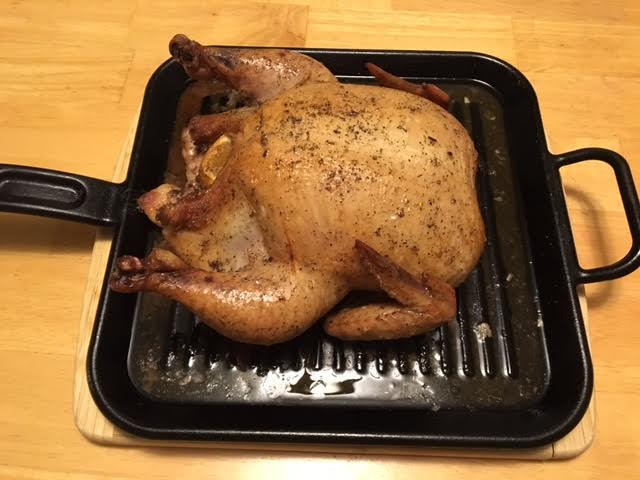Durham chicken
This is another low-and-slow recipe for the Akorn, closer to barbecuing than to smoking.

The ingredients
- one medium-ish organic chicken from Costco (the kind that comes in packs of 2)
- one lemon
- one fresh sprig of rosemary
- handful of cloves of garlic
- kosher salt
- black peppercorns (in a mill; so, basically, fresh ground pepper)
- leftover house dressing from Randy’s Pizza Greek salad; I don’t know what goes in it, but it seems to me it’s olive oil, vinegar, and the brine from canned kalamata olives with some herbs.
Prepping the chicken
- Rinse the bird and pat it dry inside and out, pluck out any feather stumps, move the giblets to the freezer.
- Crush and peel the garlic, slice the lemon, crumple the rosemary sprig. Stuff them all into the cavity.
- Give the bird a good dusting of kosher salt everywhere. Rub it in. Then go over it with the pepper mill.
- Put the bird into a covered pot and into the fridge. This is dry brining. I let mine sit there for about 3 hours, maybe less. You can use a big enough ziploc bag instead of the pot, too.
Prepping the grill
- Get a good amount of charcoal into the chimney. I’ve learned to be generous with it, because I can always reuse what’s left after the grilling is done and I turn off the vents.
- After you dump the burning coals into the Akorn, put in a chunk of Bradford pear – my smoking wood of choice; I have a whole pile of it in the basement – and set up the heat deflector with some water container on it.
- Open the bottom vent about half and inch, and crack the top vent open about one eighth of the way – aim low; you’ll want to hit about 200° and hold it. This is a function of both how much coal you got in there burning and how wide you’ve got the vents open. It takes some fiddling, but if you overshoot and have the fire burn at about 250, adjust the vents down a little and the fire will slow down toward 200 on its own soon enough.
Grilling
While the grill goes up to temperature, get the bird out of the fridge, drain the juice, pat it dry, and brush it all over with the house dressing. This is what makes this a Durham chicken: I have no idea where else you can get this particular dressing, that’s all.
Put the bird on the Akorn, close the lid, and check back with it after two and a half hours. Check sooner if you overshot and made the grill run hotter. Akorns can get the temperature up and hold it there very well; getting it back down is hard, by design. But the beauty of indirect heat barbecuing is that you have broad leeway in trading heat for time. However hot you run your grill, the chicken is done when the juices run clear. That’s my standard. Yours may well be the scientific one – namely, that the internal temperature in the thickest part of the thigh not touching bone should be 165° Fahrenheit (75° Celsius). Go with what works for you.
Putting the bird on a cast iron grill pan as shown is optional. I’ve done it both with and without it. These grill pans are easier to clean than the Akorn’s grill grate.